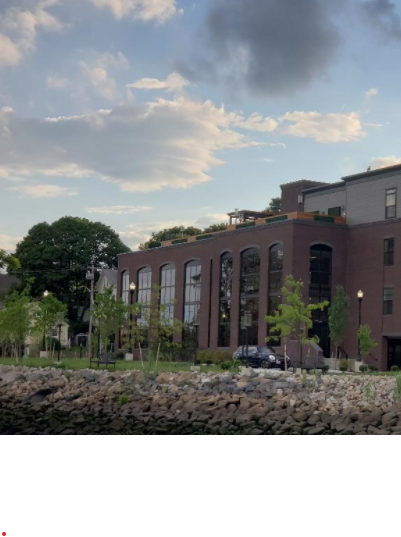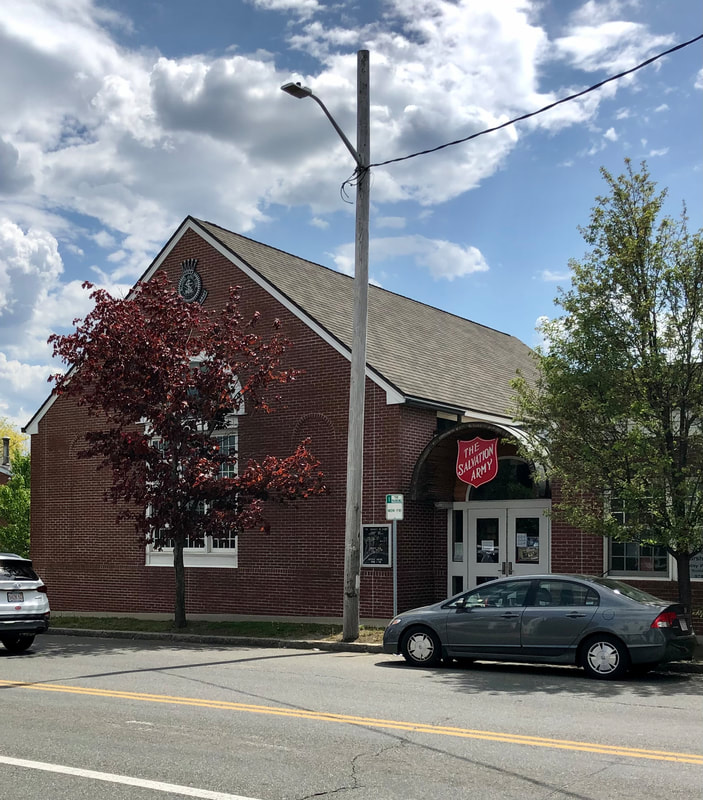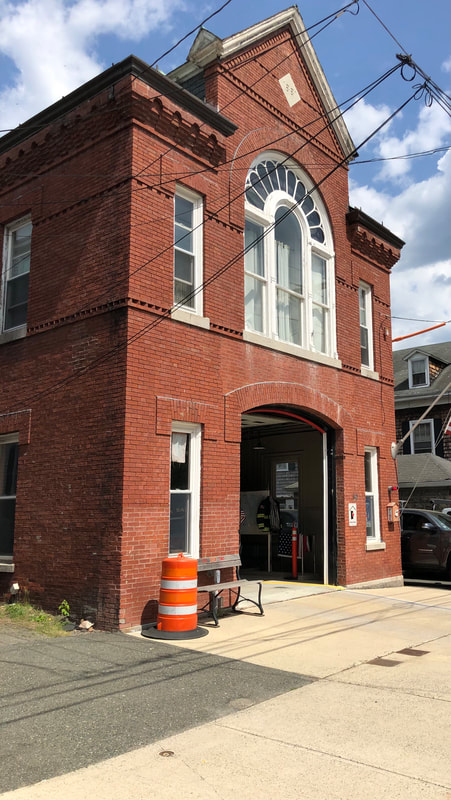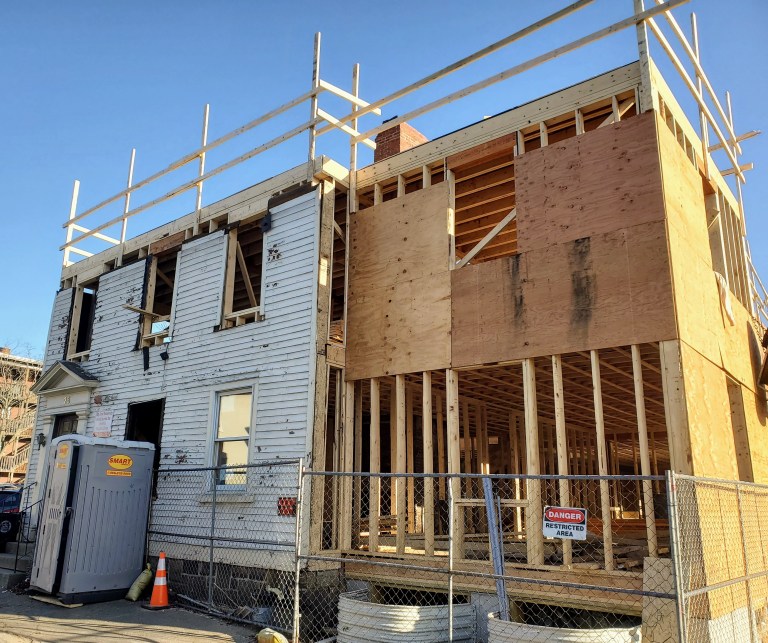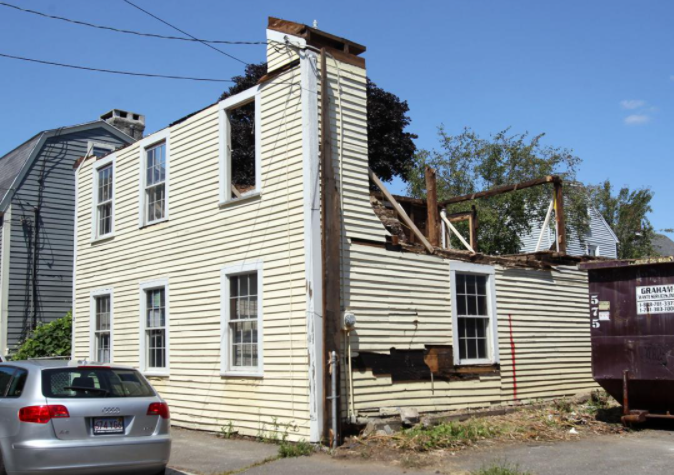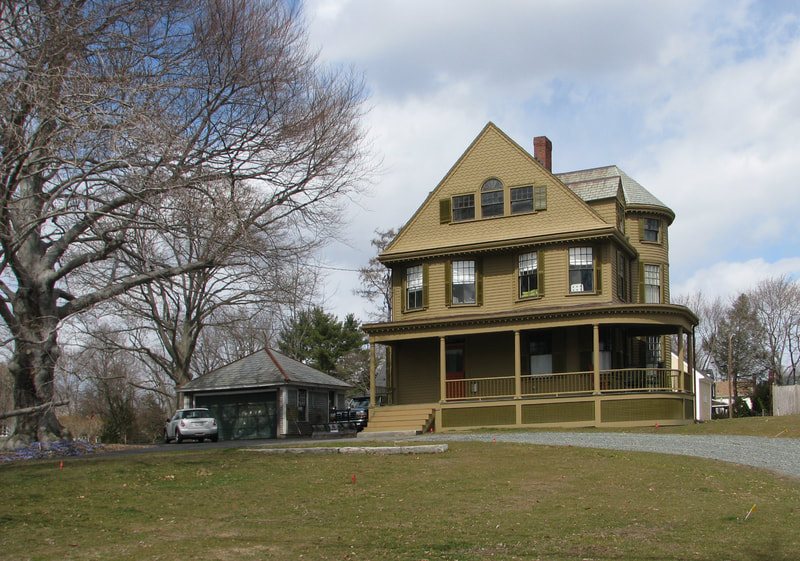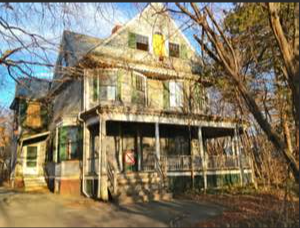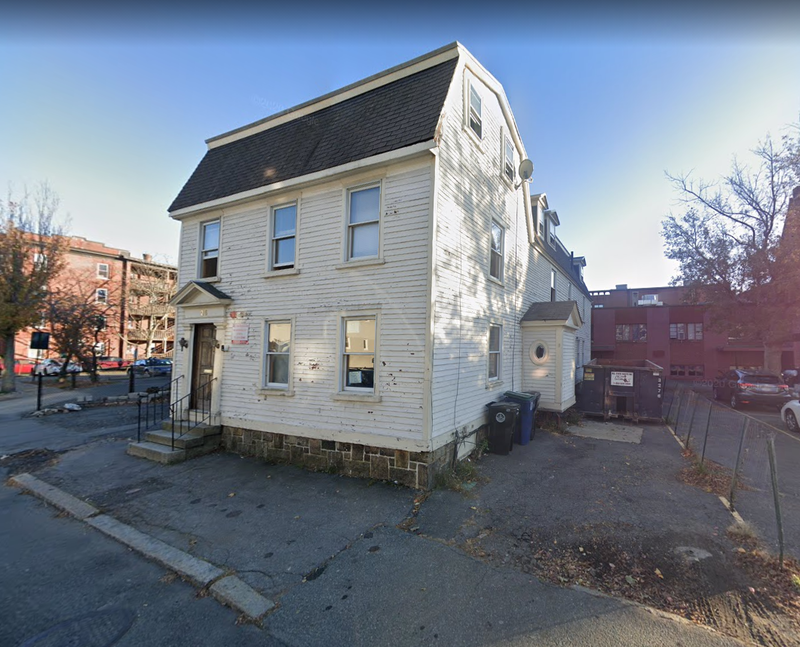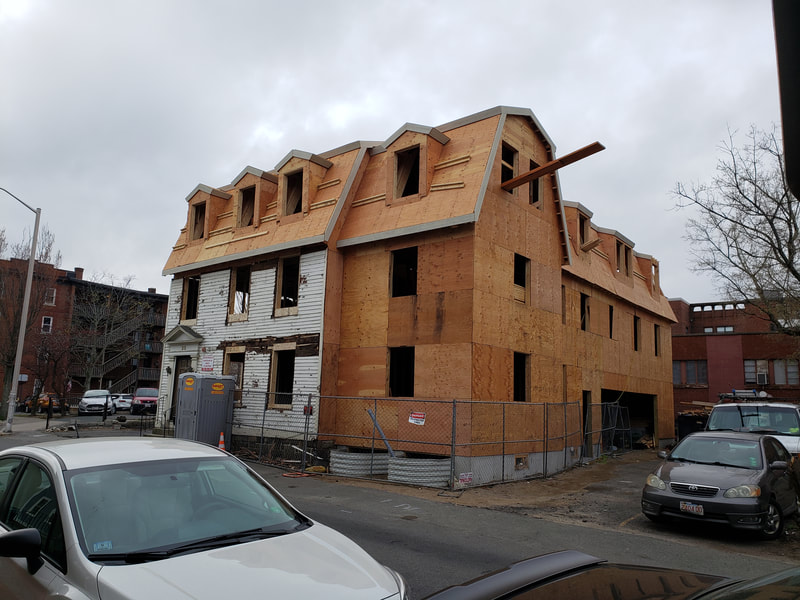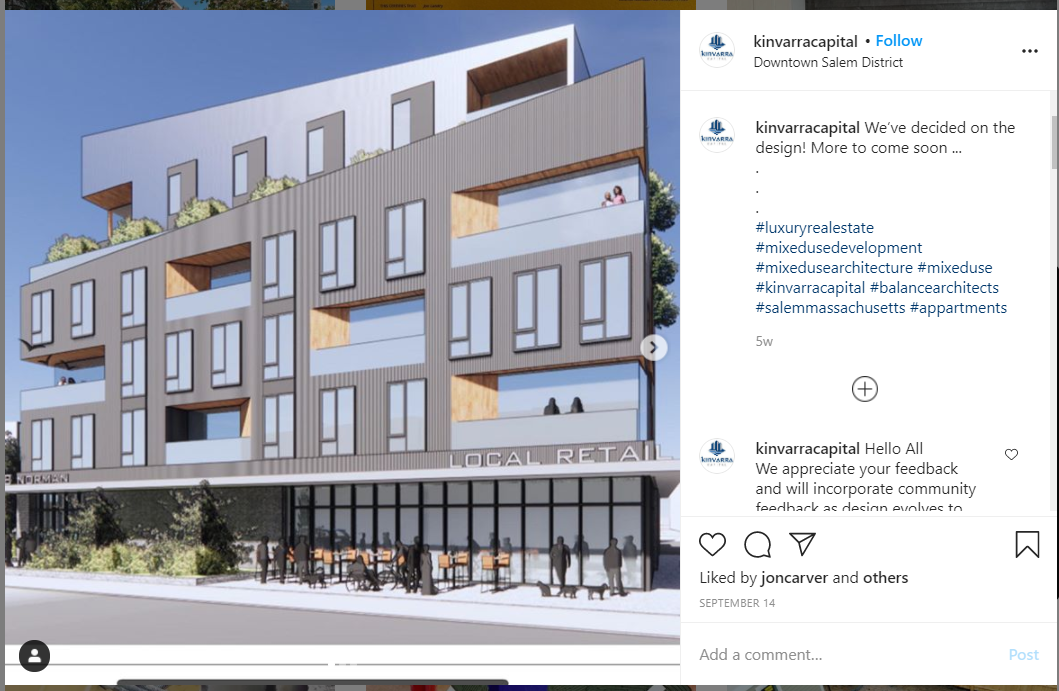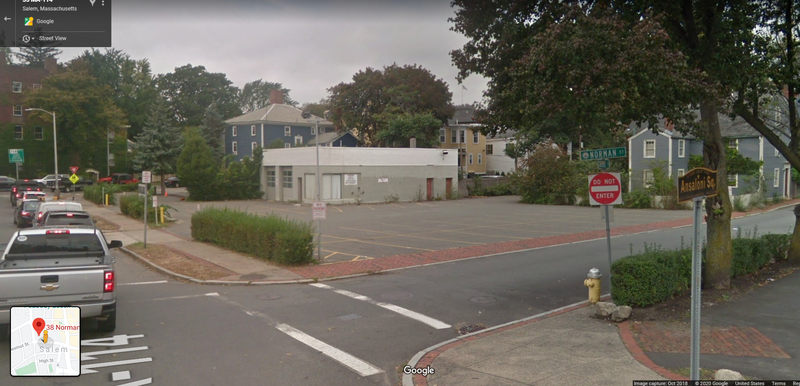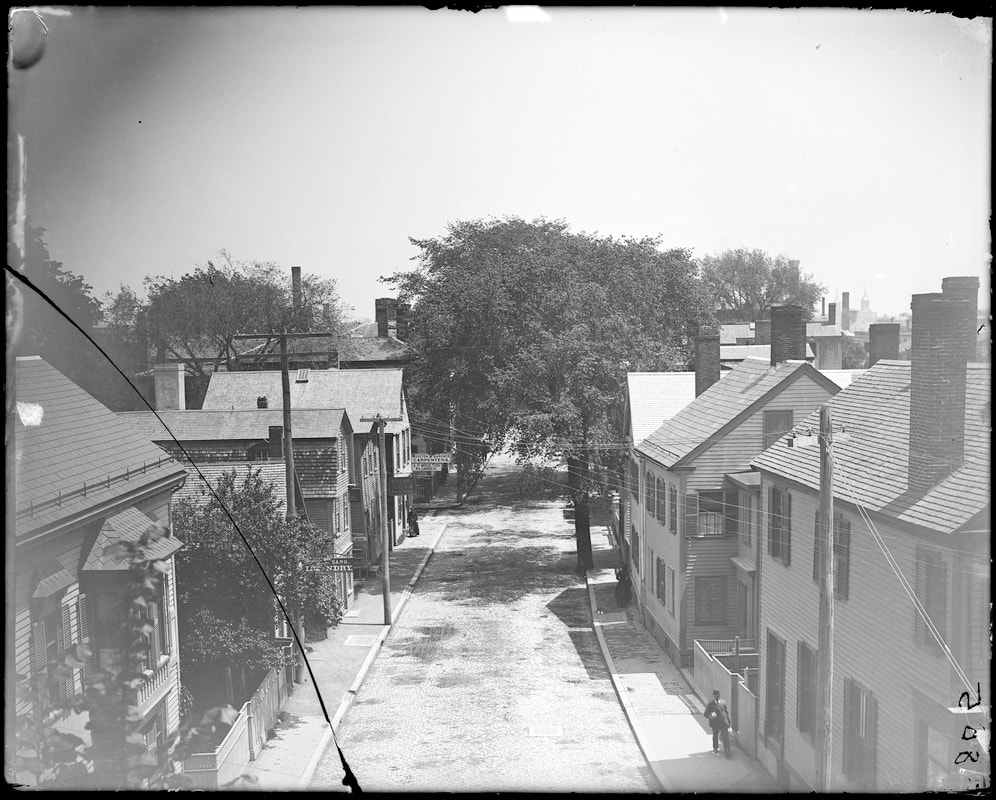|
4 Franklin Street (the former HMA car wash) sits on a major entrance corridor to our historic downtown and inside the North River Canal Corridor (NRCC). The Planning Board is reviewing a proposal to build an ambulance depot on this site and as part of the review, the Design Review Board (DRB) provided a recommendation that didn’t meet the City’s standards as outlined in the Commercial Design Guidelines (2005) or the NRCC zoning ordinance. What can you do? If you believe Salem is an important historic coastal city with a need to respect and enhance our preserved fabric, and that developers should, at a minimum, be expected to meet the existing standards, then before the next Planning Board meeting tomorrow, Thursday, July 8th, let the Planning Board know (via mwells@salem.com) that the DRB got this one wrong, and that we look to the Planning Board as the empowered municipal authority to ensure that the NRCC and other commercial design guidelines are met at 4 Franklin Street. Our take Both the North River Canal Corridor District and the Entrance Corridor Overlay District were implemented to preserve and enhance neighborhood character and to ensure that these areas are improved for the best interests of the city. City approval boards exist to administer community vision as established by documents voted on by the City Council. It is hugely disappointing for a member of the DRB to state that “we’ve put a lot of responsibility on the owner of this property to become the gateway to Salem” when, . from our perspective, Cataldo bought that responsibility when they purchased this entrance corridor plot that has been regulated by the NRCC and Entrance Corridor overlay for years. They should absolutely be held to the standards set for them by the guidelines without any question or allowances made. The Cataldo garage proposal does not meet the spirit and intent of the NRCC in many ways (including incompatible use and lack of sidewalk activation) but in addition the DRB has now recommended the massing and materiality of a building that does not reference its surrounding historic Northfields neighborhood and rejects specifically encouraged materials for the building facade. In fact, unlike other recent North St. arrivals like Valvoline and the Salvation Army Chapel, which did build with complementary materials, Cataldo seems determined to disregard the NRCC design guidelines to build a structure more like an industrial storage shed. The DRB made their decision while discounting significant and very specific public comment opposing the design and materials that were proposed and requesting more attention be paid to color, architectural detailing, and shape of the roof. What is wrong with the DRB decision?
irst and foremost, the Cataldo garage is Phase 1 of a proposed two-part development, where the second phase is a residential development along the North River. Phase 1 will set the visual and materials precedents for Phase 2 and this low standard sets a precedent for other new construction projects in close proximity including other projects on Franklin and Commercial Streets as well as the large project in early design on Bridge Street’s “Cresent Lot.” To start wrong is to end wrong. Secondly, it is giving a pass to a multi-million-dollar Massachusetts corporation with 800 employees by not requiring them to invest in the best and most compatible building design on a prominent gateway site. Part of a gateway where hundreds of thousands of visitors to our city begin to get their sense of Salem as an historic place. History means millions of tourist dollars to our city. Cataldo’s design needs to be much better, and it can be with some specific and careful design adjustments. The development team did not begin this process without guidance. There are requirement in the NRCC Zoning as well as the City of Salem’s Commercial Design Guidelines which includes the following language: Page 18: “In Salem’s Entrance Corridors…the unique architectural character of the district must come before corporate branding.” Page 24: “New Buildings need not, nor should they, imitate the…past. It is… more interesting to match materials, proportions and scale while using modern simple materials…the use of similar compatible materials and matching cornice lines…can ensure that new structures contribute to the character of the district.” Page 26: “Using materials not commonly found in the immediate surroundings will make the development stand out and appear jarring. Salem has a long tradition of wood and masonry buildings. At the same time, new materials can be incorporated into projects as secondary elements…” This site is prominent and will be clearly seen and it needs to meet the longstanding guidelines of the NRCC and the basic recommendations of the City’s own Commercial Design Guidelines. Further, the community at large has clearly expressed a desire for higher quality design and materials at this important site; many individuals have expended time and effort to articulate these community values. We invite you to share your thoughts with the Planning Board at or before the June 8 meeting by sending them to mwells@salem.com or by being prepared to speak at the meeting, which begins at 6:30pm. If you have previously provided comment to the DRB, you may want to reference that as well. We find that a wide array of respectful citizen voices is an effective way to ask boards to reconsider and hope you will add your voice to this conversation.
6 Comments
This is the text of a letter submitted to the Planning Board in advance of their May 20, 2021 meeting and to the Design Review Board in advance of their May 26, 2021 meeting. Dear Mr. Griset and Mr. Durand, As we have been participating in this community review of the proposed project at 4 Franklin Street, we have been pleased to see the unified opinion the Planning Board expressed regarding building placement and the receptiveness with which the applicant responded to this request. We have one other major concern and that is regarding the materials in this proposal. The North River Canal Corridor Zoning Ordinance in Section 8.4.2.2 highly discourages the following materials: precast concrete, pre-fabrication aluminum or metal panels. We ask the Boards to work with incoming neighborhood member Cataldo Ambulance to merge the desired look of their brand with the neighborhood’s established “brand” or, as it is described in the Zoning Ordinance, “historic neighborhood character.” The materials that are encouraged in the ordinance are brick, stone or wood. These, or similar, materials could lend a warmth and connection to place that the building, as currently proposed, lacks. The highly discouraged materials should not be allowed. There are numerous examples in the neighborhood that the architect did not identify when presenting to the Design Review Board. The Valvoline building and the Salvation Army Chapel (image attached), both designed prior to the NRCC district designation, underwent extensive design work so that the buildings could meet their function, which includes contributing to the public realm. The historic fire station building on North St. provides public safety and is a relevant neighborhood design precedent. Indeed, North Street has a wide mix of historic building uses and there are a variety of forms and materials that could beneficially influence the design of this building. Because this proposal meets so few of the stated requirements of the NRCC plan, we ask the boards to insist that the building take stronger material cues from the immediate neighborhood and from downtown Salem, the backdrop of this site. We appreciate the work these two boards do to elevate development in Salem and we appreciate the opportunity as members of the public to have our thoughts considered. Sincerely, Caroline Watson-Felt, President In 1986 Salem was on the cutting edge when city leaders implemented a six-month demolition delay ordinance. This means that when applying for a demolition permit for a building older than 50 years and owner has to wait six-months before they can demolish the building. Or they can apply for a waiver of this delay period through the Salem Historical Commission who can determine (after weighing all the factors) if the building can be torn down sooner. Theoretically this six-month time period can be used to examine preservation options for a historic building, or to develop actions that mitigate the loss of a historic building. However, in today's construction world six-months of waiting is not a sufficient incentive for an owner to work with the Salem Historical Commission on alternatives. Six months is about the same amount of time it takes to get all the other necessary approvals and so an owner can request a waiver of demolition delay and while they wait out the time clock they can visit the other boards in the city (Planning, Zoning etc) and proceed as planned. As Salem's desirability continues to rise, we anticipate an increase in “tear-down” real estate, which we are already seeing in the Willows, North Salem, and other Salem neighborhoods. Salem needs to increase the Demo Delay time period to 12 months (or even 18) and apply the requirement to partial demolition.
Strengthening the Demolition Delay Ordinance will bring clarityChanges to the demolition delay ordinance will benefit everyone.
You can read our full list of recommendations for an updated Demolition Delay Ordinance here:
You can read the City's draft ordinance here (draft as it appears on the SHC website on 4/20/2021):
You can read our letter to the Salem Historical Commission, April 20, 2021 here:
You can read our letter to the City Council, April, 22, 2021 here:
This letter was submitted to the SRA in advance of their April 14, 2021 meeting. You can review the submitted meeting material, including other public comments on the SRA website via this link.
April 13, 2021 Ms. Grace Napolitano, Chair Salem Redevelopment Authority City of Salem 90 Washington Street Salem, MA 01970 Dear Ms. Napolitano, Historic Salem writes to provide comment on the proposal for 38 Norman Street on the SRA agenda for April 14, 2021. We have been in private and public conversation with the development team and appreciate their responsiveness to our feedback, specifically on the topic of design and materials. As we shared with the development team and now with the SRA, we have significant concerns about how a building of this height will impact Crombie Street, as well as how it will fit in the context of nearby historic neighborhoods. 38 Norman sits at the juncture of Crombie, Summer, and Chestnut Streets, each of which features iconic historical Salem architecture. Directly adjacent to this site is Crombie Street, a narrow way on which are located the last remaining small-scale residential houses in the downtown area. Crombie Street is listed on the National Register of Historic Places, a designation that recognizes that “as the only surviving downtown residential group from the early 19th-century, the houses on Crombie Street provide important information about the character of the city at that time.” On the other side of this project is a Georgian-period mansion that contributes to the historic streetscape of Summer Street. Crombie and Summer Streets were once part of the larger historic residential district that included both Chestnut Street and Gedney Street, but a series of destructive urban renewal demolitions on the proposed site and nearby blocks (where the Holyoke Insurance building now stands), created a rift separating these streets from one another. This project is a rare opportunity to re-connect neighborhoods that were torn apart in the 20th century and therefore the height and massing should be inspired not by the nearby urban renewal-era infills, but by the remaining historic residential buildings. Because many of these buildings, such as the Salem Inn and 2-4 Chestnut Street are quite large, their influence can allow the developer to meet their goals within the scale and massing of the surrounding neighborhood. At five stories, the proposed building would tower over adjacent Crombie Street, including its direct neighbor, the Wendt House. This house at 18 Crombie Street was saved from demolition several years ago through the joint efforts of Historic Salem and the City of Salem. We strongly oppose allowing this height. An important SRA goal is to ensure that the designs of new downtown structures fit with the context of Salem’s remaining irreplaceable and highly respected historic architecture (Plan goals 2, 3 and 4). In order to reduce the height of the building and increase ameliorative step-backs on the ends, we also ask the developer to consider whether the building could be fully residential. Retail at this location is not clearly necessary to meet Plan goals and without easily available on-street parking it may be difficult for tenants to succeed. On the other hand, residential on the ground floor would strengthen the residential link to the past and reinforce the connection between Summer and Crombie Streets. If retail were removed then, rather than seeking PUD approval, the applicant could seek a variance on the parking requirement that the SRA, and perhaps other community members, could support. The overall massing and height of the building, the way it steps back at the ends and the uses in the building need to be addressed before the project is sent to the Design Review Board. At that point HSI will have further comments on design specifics, such as architectural treatment at the ground floor and execution of design elements. We appreciate the efforts of the SRA to review these projects according to the Downtown Renewal Plan and in the context of our historic urban core. We thank the developer for their outreach to us and other community members. We look forward to seeing how this property can become a cohesive part of this historic neighborhood. Sincerely Caroline Watson-Felt, HSI Board President With new construction projects proposed throughout the historic downtown and our ongoing efforts to expand historic protections to all Salem neighborhoods, the work we’re doing at HSI often outpaces our communications to the community. 2021 has been “all hands on deck” to collaborate with our volunteers, neighborhood representatives, developers, and City officials. Of the numerous projects underway simultaneously, there is one active project which demonstrates the imperative need for two initiatives we have been working on this year: “A Citizens’ Guide to the Downtown Renewal Plan” and an expanded Demolition Delay Ordinance. We’ll be talking more about these efforts in the coming weeks but today, let’s talk about the James Barr House at 25 Lynde Street. The home of a privateer, the James Barr House at 25 Lynde Street, is a very rare example of a pre-revolutionary building surviving in the downtown. As part of this project, the roof has been completely replaced as has much of the original historic material. The Barr House is one of many historic buildings that falls under preservation protections, not by a Local Historic District, but by the Salem Redevelopment Authority (SRA). The SRA has many-fold responsibilities - ultimately they review and approve all design and development changes in the downtown urban core. In cases where this includes new construction, the Plan says that they are to be guided by the design guidelines found in the Downtown Renewal Plan, and in the case of historic buildings the Plan says that they are to be guided by the Secretary of the Interior Standards for Historic Preservation, the same standards applied in the Local Historic Districts. Essentially the SRA acts in the place of the Salem Historical Commission for buildings within its boundaries and has similar powers to restrict demolitions and inappropriate construction. The question citizens need to ask is, is our SRA meeting the preservation standards and expectations set in the Downtown Renewal Plan?
Historic Salem has created the “Citizen’s Guide for the Downtown Renewal Plan” with the hope that this summary document will make it easier for community members to advocate for the historic buildings that are within the downtown urban area. HSI's ability to effect change is purely through advocacy and relationships, just like Salem’s citizens. Community engagement and advocacy is necessary to effect SRA to advocate for more stringent reviews and approvals for the historic buildings in their jurisdiction. A recently created abutter notification requirement will help let neighbors know about project reviews. As part of our advocacy work, we rely on the concerned public to let us know if you learn of any similar projects. In addition, the significant demolition of the Barr House is an example of why we need to strengthen the CIty’s current Demolition Delay Ordinance. Right now, a Demolition Delay is only triggered at 100% and so developers are able to retain a very small portion of the building and claim the work to be a renovation. We believe, in the case of the Barr House, that an expanded demolition delay ordinance which redefines the threshold of demolition to removal of over 50% of the exterior of a building, and an extension of the wait period from 6 months to 12+ months, would have allowed for closer oversight of the changes and design to this historic property. (We have a more comprehensive outline of what we’d like to see in an updated ordinance HERE in a downloadable file). Among other benefits, strengthening these two specific aspects of the Ordinance would allow for intervention by the Salem Historical Commission before an historic building has lost so much of its original material and appearance as to essentially have been demolished. We are working with City Councillors and City offices on this effort, and hope to see a revised Demolition Ordinance filed with the City Council this month. Ultimately, the efforts to protect and save the historic infrastructure of Salem are shared by all of us who live and work in Salem and believe in the preservation of this city’s historic fabric. We welcome the enthusiastic support from the citizens of Salem and hope that more voices will be added to the conversation in effective and productive ways by use of the “Citizen’s Guide to the Downtown Renewal Plan” and as the Council considers the Demolition Delay Ordinance. To read more about the history of the Barr House, we suggest you read Streets of Salem’s recent post. We are so grateful to have local historians and preservation enthusiasts like Donna Segar for bringing attention to these important places. There has been a growing conversation on social media in reaction to images that were recently posted on Instagram of a preliminary design for a potential building at 38 Norman Street here in Salem. Although this project has not yet appeared on any City board or commission agendas, the site is in the Downtown Renewal Area and will be reviewed by the Salem Redevelopment Authority (SRA) and the Design Review Board (DRB). The Downtown Renewal Plan is the document that these boards will use to evaluate and approve any downtown development. This is what a close reading of the Plan reveals: First - the objectives of the Downtown Renewal Plan[1] support utilizing vacant or under-utilized land and further defining the edges of the Downtown Renewal Area as it abuts other neighborhoods. Clearly, the current site used for parking is an under-utilization of this downtown location. Second - the language of the objectives and design standards overwhelmingly indicate that infill development should prioritize architectural designs that are compatible with their surroundings and are sympathetic to, or enhancing of, the historic and architectural values on adjacent properties. It is apparent that this project, as posted on September 14, would not do that. Here are a few highlights from the Design Standards for the Downtown Renewal Plan:
The other document that the Design Review Board commonly refers to and which covers a wider area than just the downtown (for example, it is used in entrance corridors throughout the city) is the Commercial Design Guidelines. These guidelines talk about how to diminish perceived height and they prioritize surrounding building heights as a primary guideline for new construction. Adjacent to this site is a narrow way, Crombie Street, on which sit the last remaining small-scale residential houses in the downtown area. Crombie Street is a National Register of Historic Places listed neighborhood, a designation that recognizes that “as the only surviving downtown residential group from the early 19th-century, the houses on Crombie Street provide important information about the character of the city at that time.”[4] To the other side is a Georgian-period mansion that sits just across the street from the historic McIntire District. This residential neighborhood is an important draw for heritage tourism in our city. Though many of the houses are large, the neighborhood is remarkably dense, with a great deal of defining period detail. Importantly, the Commercial Design Guidelines state that, “Successful commercial districts strive to retain and replace missing buildings with compatible replacements that maintain the continuity of (similar) elements. Buildings that fail to have these essential elements erode the cohesive quality of the street.”[5] The effort to replace missing buildings should be a guiding factor for design on a site that was once home to residential buildings and is now a void between two neighborhoods. The unique opportunity to serve as a bridge between the historic residential neighborhoods is missed by the current concept for this site. The incredible disconnect between height and scale of this proposal and adjacent properties will further separate the two and have a highly detrimental effect on the houses directly adjacent the property. By applying the design standards found in the Downtown Renewal Plan, we believe that this development team can achieve their project goals while also enhancing the downtown neighborhood in which it sits. Throughout downtown Salem, commercial density is achieved while still maintaining a small-city residential and retail feeling that draws pedestrians, both visitors and residents. We have reached out to the development team to offer our thoughts and have encouraged them to approach the site’s neighbors for input. As this project moves forward, we will be a strong and active voice in the public process. We invite all concerned members of the community to engage in the public review process that will likely start with the Salem Redevelopment Authority. You can sign up for their meeting notices and agendas here. https://www.salem.com/subscribe ------------------------------------ As part of our advocacy and education mission we are developing a Citizen’s Guide to the Downtown Renewal Plan. Look for that in early 2021. [1] Downtown Renewal Plan, City of Salem and Salem Redevelopment Authority, 2011. Page 3-1. [2] Ibid. Page 3-8 and 3-10 [3] Ibid. Page 3-11. [4] National Register Listing, Area Survey. Crombie Street National Register of Historic Places. 1979. Downloaded from MACRIS on October 19, 2020. http://mhc-macris.net/index.htm [5] City of Salem Commercial Design Guidelines, 2005. Page 12. https://www.salem.com/sites/g/files/vyhlif3756/f/uploads/sdg_all_pages_0.pdf Submitted to Salem Redevelopment Authority on September 24, 2020
Dear Ms. Napolitano, Chair: Having watched the September 15 and 17 SRA interviews of the three development teams responding to the Historic Courthouse Request for Proposals, HSI has the following comments to add to our previously submitted letter of September 3, 2020. We understand that the SRA is deciding which team would be the best partner in working with the City to reuse the historic Courthouses – the prime goal of the request for proposals – as well as to improve the public realm and to build a new residential building on the crescent lot. Because it is clear that each team brings relevant experience and qualified consultants, the following comments are not meant to be prejudicial. Winn Companies To ensure successful reuse of the historic Courthouses, the experience and financial stability of Winn Companies is advantageous, but we are concerned about the long-term ownership of the Superior Courthouse building. On page 69 of the proposal package, Park Towers (formerly Nine Zero Washington) is defined as being the owner of the Courthouse commercial space, albeit through a condominium legal structure. This is notable because we believe the lead developer in the team should especially have a long-term vested interest in the successful operation of the Superior Courthouse building. If the plan is to have the ownership of the Superior Courthouse building be different than the ownership of the residential units, then the qualifications and enforceable obligations of that second ownership entity are as important as those of the proposal leader. The SRA should be clear about what will happen to leasing, management, tenant buildout of interior spaces, and long-term operating guarantees once Winn completes their short-term tax credit guarantees. We are concerned that this ownership division limits advantages of Winn as the lead developer with respect to the long-term operation of the Superior Courthouse building, which is a key SRA and community concern. HSI supports courthouse uses that provide public access, like the concept of the Museum of Justice which seems particularly suited to this setting, but believes that in order to be successful a museum start up requires both substantial financial backing and programming in order to be viable and to attract sufficient visitor traffic to sustain it. JHR This team has significant local connections that would benefit the partnership and the Salem State public presence in downtown Salem in hosting lectures, presentations, conferences, and meetings, would be well suited to the grand courtroom spaces. We are also impressed by the innovative design elements in this proposal, which we agree could be functional and beneficial to the community. We reiterate, however, that there are many unknowns that could impact the feasibility of those specific site proposals, and if they did not come to fruition, the SRA should be clear about what that means for the plans overall and establish the expectation that similar innovation should be implemented in their place. North River Partnership This enthusiastic team emphasizes their willingness to work as partners with the City in redeveloping these historic buildings and adjacent spaces. A big part of that partnership will be designing the overall site and the new building on the crescent lot. Recent experience in Salem with the project’s lead developer leads us to wonder whether the architectural team, Gund Associates, will, in fact, continue with the project from beginning to end? If the design team were to change, as it did at 65 Washington Street, how would that impact their overall plan and how would the SRA regulate and reassess such a significant change? Redevelopment Process Once a development team is selected, Historic Salem looks forward to continuing our advocacy for preservation and reuse of the historic Courthouses. We will also continue to advocate for a new building that complements the existing commercial scale and fabric of Salem’s historic downtown and for publicly accessible features that create pedestrian connections through the site that add vitality to adjacent neighborhoods and our downtown. As members of the community and as stakeholders in the preservation of Salem’s historic fabric, we thank the SRA for its efforts on this significant project and for its consideration of our comments. Signed by Caroline Watson-Felt, HSI President Submitted to the Salem Redevelopment Authority on September 3, 2020
Dear Ms. Napolitano, Chair: For nearly two decades Historic Salem, Inc. has been advocating for decision-makers to facilitate the successful reuse of these historic court buildings. We look forward to the selection of a development team to make this reuse possible. As the Salem Redevelopment Authority reviews the three proposals, we offer the following comments and questions. Preservation We thank the SRA, city staff, state agencies and the developers for recognizing the value of these historic court buildings and targeting development plans that allow for their reuse. With this shared understanding and appreciation, the reuse plans can meet the goals of the Preservation Restriction, the SRA guidelines, the City Council’s goals in transferring the Crescent Lot property, and the historic preservation vision that our community has repeatedly embraced. The Massachusetts Historical Commission will rigorously review the final development plans for compliance with the Preservation Restriction and we understand that these proposals include only conceptual drawings. We note that one proposal for Superior Court that include residential uses may indicate a reduction in the width of the existing corridors and this may not meet the intent of the Preservation Restriction. Likewise, the proposal to replace all the historic windows and store the original materials does not meet the intent of the Preservation Restriction, the care taken in mothballing the buildings, or recognize the value of having the historic windows at all. Building Uses The uses planned for the historic spaces will be key to this project’s success. It has long been HSI’s position that institutional uses in the Superior Courtrooms and Law Library that parallel their historic use as gathering and judicial spaces will allow for more public access as well as retention of their volumes of space. We are pleased to see this conclusion drawn by the development teams. Each use proposed for the Superior Court building appears to allow tenant fit out that preserves the historic fabric. Therefore, it is important that the SRA clearly understands the real-life feasibility of each proposed use/tenant. We request that each development team be asked what other options exist if the proposed anchor tenant were unable to proceed, and in that case how the developer will ensure public access to the Courtroom and Law Library spaces in the future. In regard to using the former County Commissioners building for housing, we believe this can be a good fit for this space. We support others in the community asking that this project achieve ambitious levels of affordability. With the recognition that the public has limited access to financial data in order to judge feasibility we ask the SRA to represent the community’s desire for affordable housing as you review the project price proposals and proformas to ensure that there is a significant benefit to the community as a result of this conveyance of city-owned property. Urban Design All the proposals appear to improve pedestrians’ urban experience in this prominent city location by reducing the crossing distance at the intersection and by creating gathering space at the County Commissioners’ green and on the plaza space on the Crescent Lot. We feel the JHR proposal demonstrates the highest amount of creativity and an understanding of Salem’s urban conditions at this location, as demonstrated by the seamless integration of existing amenities with new connections. In all cases we will be looking for the selected team to enable connections between existing pedestrian access points (North Salem, Salem’s downtown and the Bridge Street Neck neighborhood) and enhanced ties to nearby neighborhood amenities such as Leslie’s Retreat and Furlong Parks. This is another way that the community will benefit from this transfer of public land. We also look forward to integration of plans between the development of these sites, the updated Harbor Plan, and the bike and open space planning process throughout the downtown. We are supportive of using railroad rights-of-way but note that these have consistently been obstacles in other planning processes and would like to understand what work the development teams have done to address those issues. We would also like to better understand access to the North River and how that will work with the significant tidal levels of the river and the need to cross the often-busy access road to the MBTA parking garage to reach the water. New Construction in Historic Downtown Salem In considering the proposed designs for the Crescent Lot, we have the following comments: The design should be led by the strong presence of 19th and early 20th century commercial and mixed-use buildings of Salem’s downtown. Just as the row of court buildings on Federal Street reminds us of Salem’s central role in Essex County law through the centuries, the historic commercial buildings along Washington St. remind us of Salem’s prominence as a commercial center in Essex County throughout its history. A new building that will define the entrance to Salem for thousands of people should be related to this commercial heritage. The final design must be rooted in a sense of place and meeting the conditions of the City Council in transferring the Crescent Lot, in this case that the resulting project be, “compatible with uses in terms of scale, use, design, and historic character.” This will be achieved through a study of scale, massing and detailing of materials. While the Ruane Judicial Center and the MBTA garage are prominent contemporary buildings, we find their size and massing out of scale with the rest of Salem’s downtown and they should not be used as precedents for this development. As community advocates, we will support either traditional-style designs or complementary contemporary designs. A ready and successful example is the addition to the Probate and Family Court building that references the adjacent historic buildings in size and massing and marries tradition and modernity through the window patterns and materials. The building elevations as measured from Bridge Street should not exceed four stories in keeping with longstanding downtown scale and, in particular, we think that the proposal for a 15-story building is significantly incompatible not only visually but according to zoning, wetlands regulations, or public safety infrastructure including fire department capabilities. The mass of the building should be considered from downtown as well as approaching the site from North Salem on North Street. We request that each development team illustrate how the building sits on the foreground of Salem’s downtown by having a view shown from the intersection of North and Commercial Street, as was provided by Winn Development. As stated in Section 3 – Design Standards of the the Downtown Renewal Plan, “Large scale developments or buildings shall be reduced in overall impact by providing variation in building massing,” with the standards presenting specific ways this can be achieved. Window patterns should be rhythmic, the street level should be pedestrian friendly at all sidewalks, materials traditional or modern should be finely detailed. We look forward to the upcoming interviews of each development team and will provide further comment after their completion. Thank you again for your rigorous review of these projects and for consideration of our comments. Sincerely, Signed by Caroline Watson-Felt, President Read their responses to the question: Why HSI?  Lori Boudo - I have lived in Salem for 20 years now and was first attracted to this great city because of its ‘oldness’—in its architecture, its history and it’s lifelong residents. As a volunteer for Christmas in Salem, I’ve become more acquainted with the mission of Historic Salem and am inspired to learn more and do more for this city I love. I am particularly interested in the history of Black Americans in Salem and proudly participated as a volunteer and contributor for ‘Salem’s Black Heritage’, a self-guided audio tour. Thanks for the opportunity to serve in this way. 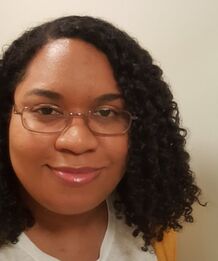 Colleen Brewster - As a child, every three weeks my family and I would travel to Virginia to visit my grandmothers’ side of the family where we had a second home. At 8 years old I vividly remember helping my grandfather install vinyl siding and being disappointed that he would only let me work on the areas I could reach from the ground. I had so much fun helping him work on the house that I knew ‘this’ is was what I wanted to do when I grew up. I continued to be his helper and worked my way up from holding the flashlight, passing him tools, and hammering, to helping him cut and install the porcelain tile floor in his basement. It has been nearly 20 years and that floor is still in great shape. My family and I would also visit my godfather on Martha’s Vineyard throughout my childhood and beyond, so I’ve been appreciative of the charm New England has to offer for quite some time. In 2002 I moved to Massachusetts to continue my education in Architecture, quickly fell in love with the area, and decided to stay. Although I no longer live in Salem, I’ve worked in this City since 2005. If there is one thing I’ve developed in that time, it’s a passion for preservation, restoration, and the use of historically accurate materials. I’ve also spent nearly 5 years recording minutes for multiple Salem Boards and Commissions, and I’ve seen projects of all types seeking approval, and even presented a few of my own projects on behalf of my clients at Gray Architects. The built environment is always one of the first things to catch my eye when I travel, and I’d like to believe the architecture that surrounds us is at least one of the reasons why visitors travel to Salem, not just for the witches, ghost tours, and Hocus Pocus filming locations. While some rehabilitation and renovation projects are necessary due to age, deterioration, or code requirements, many are completed for modern conveniences; a family room with enough wall space for the big screen TV, creating an en suite so you don’t have to share the bathroom with the kids, adding an HVAC condenser unit, etc. These structures and subsequent additions tell the story of their evolution and those histories need to be preserved using appropriate methods that retain the integrity of these structures. If it were not for organizations like HSI working with local Boards and Commissions, many of the existing historically or architecturally significant buildings that surround us would have either disappeared long ago or be barely recognizable today. HSI provides another level of oversight that pushes for higher standards of quality design that will enrich the neighborhood, take the context of the surroundings into consideration, and insist upon the respect for the districts that have been preserved. A preservation group with these goals is a organization that I would be proud to be affiliated with. 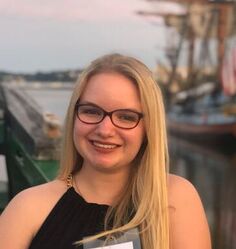 Amanda Eddy - I am a young and passionate Salem State University public history graduate. Homegrown in Salem, this city has always been a constant in my life. From a young age, history has been my passion. As soon as I learned about HSI's mission, I knew I had to join in and help however I could. I feel as an active member of the historic preservation community in Salem, I'm going to make a great addition. I hope to add some new ideas, and I'm excited to hear about other plans and ideas from other passionate historians. I have been taking Christmas in Salem tours since age 6 and have been a volunteer and house captain for at least two years. I also write house histories for HSI which is my favorite part! I love being able to not only contribute to the organization and share my talents, but also continue to learn more and more about the houses that I am surrounded by in my daily life. I love HSI because we have the same goal - historic preservation. To keep our city's heritage and history alive. I appreciate this opportunity to be a part of HSI's board for the next few years to come and I hope I can make a youthful difference! 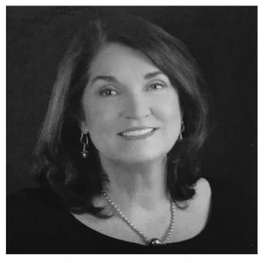 Jessica Herbert - Preservation is not something that I choose to do over something else—It’s a systemic drive that has been the focus of my life as early as I can remember. As a young child, I was drawn to the historic homes of Virginia, including my ancient family home on the point of land at the head of Hampton Roads. Herbert House, circa 1753 is a brick Georgian mansion which sits adjacent to the site where Black Beard (Edward Teach), the infamous 18th century pirate’s severed head was mounted on a pole at that point where the Hampton and James Rivers meet. This dramatic bit of history, along with many others of the Revolutionary & Civil War's surrounding battles, made Herbert House’s history and standing within the history of Hampton, Virginia all the more interesting to me growing up in its midst. In the late 1980s, the renovation of Herbert House became my obsession, for it had languished without care during much of the 20th century and was about to be razed by a developer who wanted to build a marina on its magnificent waterfront acreage. Despite being on the National Register, I found that it had no protection from the local historical commission. It was a monumental struggle to save it — lasting more than 20 years — but it is now fully restored, despite sharing the waterfront portion of its former land with the new millionaire-row marina. My interest in working with HSI is a direct consequence of my experience with Herbert House, which has taught me how important it is to use all the tools available to educate and to save historic buildings and landscapes. Money and politics play an important role in preservation, and it is critical to be aware of where preservationists can have the most impactful and sustained influence if they are to be successful in preventing the loss of the historic fabric of their city through the ravages of poor and inappropriate renovations, and wholesale eradication. I have spent 36 years in Salem, and I love this City! I started here with the complete restoration of an important Victorian mansion that had fallen into shameful ruin after many decades of neglect. Within 10 months of sustained and cherished effort, it retook its place as an important historic element of the McIntire Historic District. From there, I realized what my role could be in working to save Salem’s rapidly changing historic character. That role would develop over time, and eventually lead to serving on the Salem Historic Commission for 16 years, 10 years as Chair. I enjoyed creating partnerships with builders, homeowners, architects, attorneys, various non-profits (including HSI), for-profits, and related departments within the changing City administrations, resulting in the collaborative restoration of scores of historic buildings throughout the City. I am honored to be a part of HSI, and support HSI’s efforts to expand and create new local historic districts in neighborhoods seeking these protections, and to work on an improved demolition delay ordinance. These protections will help maintain the historic character of Salem for future generations. HSI is the organization where I feel I can best share my skills, experience and passion for historic preservation. Thank you to the nominating committee and the Board of Directors for this opportunity to be of service in the realm that I love. Dear Members, Supporters, and Friends,
As we think about the families, loved ones, and neighbors of George Floyd, Breonna Taylor, Ahmaud Arbery, and so many others, whose senseless murders have sparked a nationwide call for justice and a renewed call to address systemic racism and inequalities in America, we here at HSI have taken this time to quiet our own presence on social media so that we could reflect on the power of historic preservation, the traditional practices of protecting our past, and the dynamics of power and economics that determine who writes history. We’ve been asking ourselves, as a 75-year-old organization, what has our part been in perpetuating injustices, inequalities, and cultural erasure in seeking to protect that which we have helped to define as “the historic resources of Salem?” What have we done to bring greater awareness to the true breadth of cultural and economic variety and diverse populace of almost 400 years of life and commerce in Salem, Massachusetts? Recently, we have been working to expand Local Historic Districts and Neighborhood Conservation Districts to more neighborhoods, and to offer more inclusive house histories and plaques, but those efforts have not been done with current and past inequalities and injustices at the very forefront of our efforts. We commit to dig deeper into the stories we tell, the research we conduct, and to expand our educational programming; we must increase our support and promotion of the work of others who are elevating a more inclusive telling of Salem’s storied past which includes the lives of many Black, Indigenous, and People of Color. We want to acknowledge that HSI, as its own institution with privilege and position in Salem’s community, likely participated in exclusionary practices by focusing protections on some but not all of Salem’s neighborhoods, perpetuating the white privilege inherent in the retelling of America’s history and through what has been deemed “significant” in defining our city’s historic character. As an organization, we must come to terms with this and commit to work diligently to dismantle racism and exclusionary practices in historic preservation when we see them. We acknowledge and support the Black Lives Matter movement. This movement now motivates us at HSI to include the telling of the lives and history and living experience of Black people in Salem and beyond from those enslaved here in the 17th century through today’s residents. It is HSI’s mission to, “ensure that the historic resources of Salem, Massachusetts, which are the key to its identity, its quality of life, and its economic vitality, are preserved for future generations and that new development complements the historic character of the city.” We recognize that we must work to expand our understanding of what Salem’s identity and character have included and therefore work to preserve more stories, buildings and cultures. Moving forward with increased self awareness and a commitment for change, we will share the resources that we’re using to educate ourselves; we’ll share the work of other organizations that highlights the lives and stories of People of Color and Indigenous people from Salem’s history, and we will elevate work being done in the preservation community nationwide that could give us direction for how we might do similar inclusivity work in our own community. It is our goal to acknowledge the experiences of our neighbors who are still marginalized today, and those from our collective past, in the hopes that together, we might help to build a more inclusive community and a more equitable future. It has been said before by others, and we now adopt and commit to the belief that historic preservation is not, and can not be, a neutral or exclusionary act. Below is a list of resources to check out - preservation advocates, history lovers, neighbors, let’s get to work. Historic Salem, Incorporated Resources Read: Stamped from the Beginning: The Definitive History of Racist Ideas in America, by Ibram X. Kendi Read: Black Lives, Native Lands, White Worlds: A History of Slavery in New England by Jared Ross Hardesty Follow and Support: Not Your Momma's History, Cheyney McKnight |
Categories
All
Archives
February 2024
Follow us on Instagram! |
||||||||||||||||||||||||




